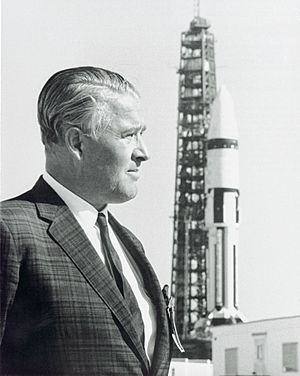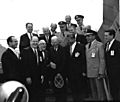Wernher von Braun facts for kids
Quick facts for kids
Wernher von Braun
|
|
|---|---|

Von Braun in 1960
|
|
| Born |
Wernher Magnus Maximilian, Freiherr von Braun
March 23, 1912 |
| Died | June 16, 1977 (aged 65) Alexandria, Virginia, U.S.
|
| Burial place | Ivy Hill Cemetery (Alexandria, Virginia) |
| Citizenship | Germany, United States (after 1955) |
| Alma mater | Technical University of Berlin |
| Occupation | Rocket engineer and designer, aerospace project manager |
| Spouse(s) |
Maria Luise von Quistorp
(m. 1947–1977) |
| Children | Three |
| Parent(s) |
|
| Awards |
|
| Military career | |
| Allegiance | |
| Service/ |
|
| Years of service | 1937–45 |
| Rank | |
| Awards |
|
| Other work | Rocket engineer, NASA, Chief Architect of the Saturn V rocket of the Apollo manned lunar missions, engineering program manager |
Wernher von Braun (born March 23, 1912 – died June 16, 1977) was a German engineer and scientist. He was a very important rocket designer in the 20th century. He worked on rockets for the German government during World War II.
After the war, he moved to the United States. There, he became a US citizen in 1955. He then worked for NASA, the American space agency. He helped create the V-2 rocket, which was the first rocket to reach outer space. He also helped design the Saturn V rocket. This powerful rocket took people to the Moon during the Apollo 11 mission in 1969.
Contents
Early Life and Rocket Dreams
Wernher von Braun was born in Wirsitz, which is now in Poland, on March 23, 1912. His father was an important bank director and later a government minister. His mother was Emmy von Quistorp.
When he was 8, his family moved to Berlin. At age 13, he received a telescope as a gift. This made him very interested in astronomy and space. He struggled in school for a bit, so he went to a boarding school. There, he bought a book called The Rocket into Interplanetary Space by Hermann Oberth. This book was very important for modern rocket science.
In 1930, he finished school. He then started studying at the Technical University of Berlin. He also studied for a short time in Switzerland.
Working on Rockets in Germany
In 1933, von Braun began working on rockets for the German Army. He earned his Ph.D. in 1934. He developed two early rockets, "Max" and "Moritz," which flew very high.
His team then developed a new rocket called the A-3. The test area they were using was too small for this bigger rocket. So, von Braun and his team of about 90 people moved to a larger test site in Peenemünde.
In 1937, during the time of the Nazis, he joined the S.S. While in Peenemünde, he worked on a new rocket called the A4. This rocket was later renamed the V-2. The "V" stood for "Vergeltung," which means "revenge" in German.
The V-2 was the first long-range missile used in war. It could carry a one-ton warhead and travel hundreds of miles. In 1943, Germany started making many V-2 rockets. Thousands of people who were forced to work were made to build these rockets. These rockets were fired at cities like Antwerp and London. More than 3,700 people died in Antwerp from V-2 attacks. Von Braun and his team also started working on newer versions of these rockets.
Building Rockets in America
Starting Fresh in the U.S.
In 1945, after World War II ended, von Braun and about 100 other scientists came to America. They started working for the United States Army. They taught American soldiers how to launch the V-2 rockets that had been captured. Von Braun became an American citizen in 1955.
During the 1950s, von Braun tried to get support for an American space program. When the Soviet Union launched Sputnik, the first satellite, in 1957, the United States finally started its own space program. At first, the Navy tried to launch a satellite, but their rocket exploded. Then, the Army took over the satellite program. Von Braun and his team successfully launched a satellite into orbit on January 31, 1958, using the Redstone rocket.
Working at NASA
In 1950, von Braun began working at the Army's Redstone Arsenal in Huntsville, Alabama. This place later became NASA's Marshall Space Flight Center. There, he and his team developed the Redstone missile.
In 1959, von Braun and other German scientists joined NASA. His most famous rocket was the Saturn V. This huge rocket carried astronauts to the Moon. After the Apollo 11 Moon landing in 1969, public interest in the space program began to decrease. In 1972, von Braun left NASA. He then worked for a private company called Fairchild Industries.
Later Years and Legacy
Wernher von Braun retired from work in January 1977 because he was sick. He passed away that same year at age 65 from colon cancer.
Von Braun's work greatly expanded what humans could see and do in the universe. His rockets were used for launching satellites, going to the moon landings, and exploring deep space exploration.
Wernher von Braun Quotes
- "Science does not have a moral dimension. It is like a knife. If you give it to a surgeon or a murderer, each will use it differently."
- "I have learned to use the word 'impossible' with the greatest caution."
- "My experiences with science led me to God. They challenge science to prove the existence of God. But must we really light a candle to see the sun?"
- "It takes sixty-five thousand errors before you are qualified to make a rocket."
- "The best computer is a man, and it’s the only one that can be mass-produced by unskilled labor."
- "Basic research is what I am doing when I don't know what I am doing."
Images for kids
-
First rank, from left to right, General Dr Walter Dornberger (partially hidden), General Friedrich Olbricht (with Knight's Cross), Major Heinz Brandt, and Wernher von Braun (in civilian dress) at Peenemünde, in March 1941.
-
Von Braun, with his arm in a cast, Walter Dornberger (on the left) and Bernhard Tessmann (on the right) surrendered to the Americans just before this May 3, 1945 photo.
-
Wernher von Braun at a meeting of NACA's Special Committee on Space Technology, 1958
-
Von Braun with President Dwight D. Eisenhower, 1960
-
Walt Disney and von Braun, seen in 1954 holding a model of his passenger ship, collaborated on a series of three educational films.
-
Von Braun during the Apollo 11 launch, with binoculars to watch it
-
Charles W. Mathews, von Braun, George Mueller, and Lt. Gen. Samuel C. Phillips in the Launch Control Center following the successful Apollo 11 liftoff on 16 July 1969
-
Von Braun and William R. Lucas, the first and third Marshall Space Flight Center directors, viewing a Spacelab model in 1974
-
In 1970, Huntsville, Alabama honored von Braun's years of service with a series of events including the unveiling of a plaque in his honor. Pictured (l–r), his daughter Iris, wife Maria, U.S. Sen. John Sparkman, Alabama Gov. Albert Brewer, von Braun, son Peter, and daughter Margrit.
See also
 In Spanish: Wernher von Braun para niños
In Spanish: Wernher von Braun para niños
















